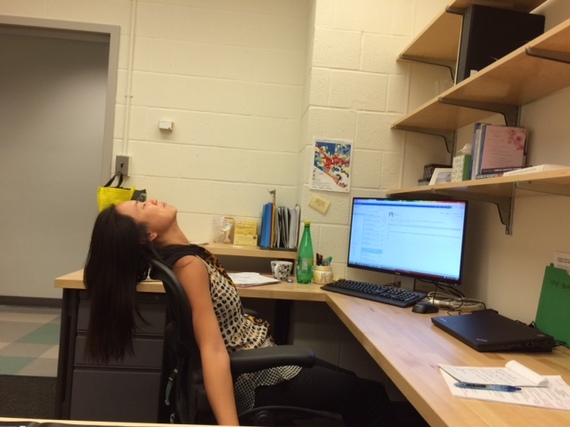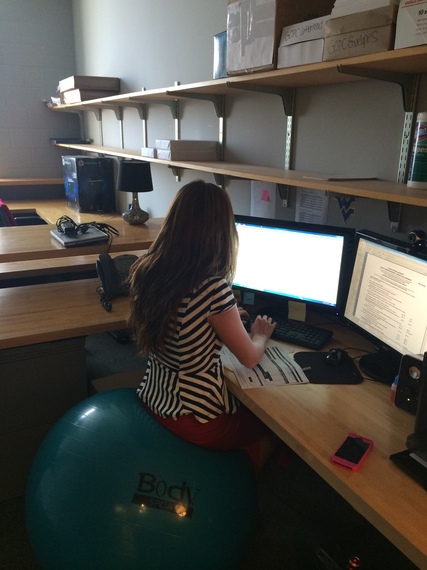By now, you may have heard of the saying "sitting is the new smoking." Of course, this can never be exactly correct. You can't be harmed by secondhand sitting or get discolored teeth from sitting, unless you are sitting in a very, very unusual way. This saying is meant to convey the health hazards of sitting too long each day. Studies have suggested that sitting too long can lead to a variety of health problems including obesity and diabetes as well as muscle and back problems. And the concern is that even participating in sports and aerobic exercises may not counter the negative health effects of sitting for too much of the day. The body may not be designed for the sedentary lifestyles that many now have. And increasingly we are doing more and more from the sitting position as Yeeli Mui of the Global Obesity Prevention Center (GOPC) at Johns Hopkins demonstrates below:
So how can you reduce your sitting? Here are 10 ways:
1. Install desk contraptions.
If you spend a third of your time each day at work... and you sit a lot for work... well then that's a lot of sitting. A recent trend is installing standing desks and replacing chairs with contraptions that force your body to work a bit harder while sitting (e.g., stationary bicycles or exercise balls, as the one Maggie Rudinger of the GOPC is using in the picture below) at workplaces. Standing desks are (or can be adjusted to be) tall enough for you to stand while working. Of course, many of these contraptions can be expensive. For example, standing desks range from several hundred dollars to several thousand (although improvisation can help you build a standing desk that is less expensive). Also, standing while working can have negative health effects too by placing too much stress on your shoulders, back, spine, knees, and legs. So while desk contraptions can be helpful, they aren't the only thing you can do to reduce sitting time.
2. Take frequent breaks.
Rather than standing or sitting all the time, balancing the two may be better. However, taking breaks can be challenging when you are engrossed in your work or by what's on your computer screen. Setting up an alarm or other reminder to stand up and walk around at least once an hour may be helpful. Also, the more social your workplace may be, the inclined you may be to take breaks.
3. Reduce your driving.
Unless you are driving a new type of car that I am not aware of (e.g., a car that you have to pedal... which would then be called a bicycle), you are sitting and generally physically inactive when you are driving. Sure you may pump your fist when someone cuts in front of you or perform some mild car dancing when "Build Me Up Buttercup" comes on the radio, but driving time is sitting time. Think about how long you drive each day and that's how long you are sitting. Could you replace some of that driving with walking, cycling, pogo-sticking, or taking public transportation?
4. Offer your seat to others.
Yes, yes, taking public transportation also may involve sitting. But unlike driving for which standing up and strolling around the car is frowned upon, public transportation does afford you the opportunity to be at least a little more active. Moreover, when on a train or a bus for a short ride, do you really need to sit down? If you can stand, offering others your seat can be kind and chivalrous... to yourself.
5. Do your job well.
You may dislike your job. Especially with so many speeches, books, and blogs telling you to do what you love, you may be inclined to minimize the amount of work that you have to do at your job and instead dedicate time to checking your social media pages, surfing the Web, or playing fantasy sports or computer games. While aspiring to do what you are meant to do is not necessarily a bad thing, reality means that you will never get to what you love all the time. Every career has its drudgeries (e.g., professional athletes, musicians, actors, and actresses, all have to toil through things that they do not like). If you are stuck in a job that you do not like, why not benefit your health by doing it well? Not only will it generate good references and experience for your next career steps, it will help others and you by staying active.
6.Help others.
When you help others, you usually can't just sit, unless you are saving a seat or trying to flatten an object for them. Many acts of kindness involve doing something physically active, such as helping others by lifting, opening, carrying, constructing, fixing, or bringing an item. Even if you hate people, think of helping others as helping yourself... to stay active.
7.Replace electronic communications with more direct communications.
At one of my previous workplaces, a co-worker in the office next to mine used to email me questions even when she knew I was in my office... instead of taking about ten steps to visit me. Now while this may have saved her valuable Tetris-playing minutes each day, it represented missed opportunities to stand up and walk around. So instead of messaging someone via email, text, or social media, consider walking over to their location to talk or at least giving them a call.
8.Do your own household chores.
A few years ago, a friend of mine complained to the head of her Division that her job was so busy that she didn't have time to do her routine chores and errands. His advice to her? Hire people to do her chores and errands. While his "advice" clearly showed a weak grasp of what she was really complaining about, it also was in line with a growing movement -- hiring others to do physical labor for you. But remember all those chores such as laundry, vacuuming, etc. keep you physically active.
9. Get outside.
You may be less inclined to sit for long periods while working, playing, and relaxing outside your home or office. The external stimuli of other people, sites, sounds, and birds dropping pellets may prevent you from losing track of time and your sitting.
10.Stand during meetings.
Jim Sallis, Distinguished Professor of Family and Preventive Medicine at the University of California, San Diego, encourages people to stand as much as possible during meetings. Such standing not only helps prevent sitting, but also helps you pay better attention to the meeting (it is harder to fall asleep while standing but remarkably some people are still able to do so). In fact, after someone gives a talk, Jim will often motivate everyone to give the person a standing ovation... which is also a nice touch. I can say that if I give a talk and Jim is in the room, I will almost always be guaranteed a standing ovation.
In many ways, reducing sitting involves reconsidering and reconfiguring many of the things that you are doing in your life. Obesity results when there is an imbalance between energy consumption and utilization in the body . Many things can cause such an imbalance. Sitting too much is one possible cause but by no means the only cause. Of course, reducing your sitting does not mean that you can eat or drink whatever you want or should forego additional exercise. In many ways, obesity is a sign that something is amiss in our lives and the systems around us.
And that shouldn't sit well with you.

